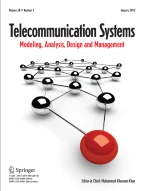Abstract
Currently, it is possible to modify (say, hourly) the topology of a data communications network by adding or deleting network links and/or by increasing or decreasing bandwidth on existing links in response to changing traffic loads and/or projected network conditions. The intent of this paper is to study a Markov decision process (MDP) model of the dynamic topology problem (DTP), the problem of activating and/or deleting links, as a function of the current traffic in the network and of the most recent network topology design. We present a decomposition of this model and structural results for the decomposition. The decomposition and structural results enhance the tractability of procedures for determining optimal link control policies. A numerical example is used to illustrate these results.
Similar content being viewed by others
Explore related subjects
Discover the latest articles, news and stories from top researchers in related subjects.References
E. Altman and P. Nain, Optimal control of theM/G/1 queue with repeated vacations of the server, IEEE Trans. Auto. Control 38(1993)1766–1775.
D. Bertsekas,Dynamic Programming: Deterministic and Stochastic Models (Prentice-Hall, Englewood Cliffs, 1987).
R.M. Bournas, F.J. Butler and D. Teneketzis, Optimal flow control allocation policies in communications networks with multiple message classes, IEE Trans. Auto. Control 38(1993) 390–403.
R.M. Bournas, F.J. Butler and D. Teneketzis, Properties of optimal hop-by-hop allocation policies in networks with multiple transmitters and linear equal holding costs, IEEE Trans. Auto. Control 36(1991)1450–1463.
C. Derman, On optimal replacement rules when changes of state are Markovian, in:Mathematical Optimization Techniques, ed. R. Bellman (University of California Press, Berkeley, CA, 1963).
R.-H. Hwang, Routing in high-speed networks, Ph.D. Dissertation, Department of Computer Science, University of Massachusetts, Amherst (1993).
L. Kleinrock,Queueing Systems Volume II: Computer Applications (Wiley, 1976).
L. LeBlanc and J.H. Harder, Optimization models for design and routing in wide-area data-communication networks, Stud. Locational Anal. 6(1994)3–18.
L. LeBlanc, Design and operation of packet-switched networks with uncertain message requirements, IEEE Trans. Commun. 38(1990)1223–1230.
L. LeBlanc and R. Simmons, Continuous models for capacity design of large packet-switched telecommunications networks, ORSA J. Comp. 1(1989)271–286.
A.M. Makowski and A. Shwartz, On constrained optimization of the Klimov network and related Markov decision processes, IEEE Trans. Auto. Control 38(1993)354–359.
R.L. Moose, Modeling networks with dynamic topologies, ORSA J. Comp. 1(1988)223–231.
R.L. Moose and R.E. Nance, Link models for networks with dynamic topologies, Technical Report SRC 87-006, Systems Research Center, Virginia Polyrechnic Institute and State University (1987).
R.E. Nance and R.L. Moose, Link capacity assignment in dynamic hierarchical networks, Comp. Networks and ISDN Syst. 15(1988)189–202.
M.D. Noakes, J.B. Cain, J.W. Nieto and E.L. Althouse, An adaptive link assignment algorithm for dynamically changing topologies, IEEE Trans. Commun. 41(1993)694–706.
K.W. Ross and D.H.K. Tsang, Optimal circuit access policies in an ISDN environment: A Markov decision approach, IEEE Trans. Commun. 37(1989)934–939.
G.N. Rouskas and M.H. Ammar, Dynamic reconfiguration in multihop WDM networks,Proc. Photonics, 1993.
J. Shor and T.G. Robertazzi, Traffic sensitive algorithms and performance measures for the generation of self-organizing radio network schedules, IEEE Trans. Commun. 41(1993)16–21.
C.C. White and K. Schlussel, Suboptimal design for large-scale multi-module systems, Oper. Res. 29(1981)865–875.
C.C. White and K. Schlussel, Optimal replacement policies for completely observed multi-component systems,Proc. Southeastcon, Williamsburg, VA, 1977.
C.C. White and D.J. White, Markov decision processes, Euro. J. Oper. Res. 39(1989)1–16.
I.S. Gopal and T.E. Stern, Optimal call blocking policies in an integrated services environment,Conf. Inform. Sci. Syst., Johns Hopkins University, 1983, pp. 383–388.
Author information
Authors and Affiliations
Additional information
Research supported by ARO Contract No. DAAG-29-85-K0089, NSF Grant No. ECS-8708183, and DCA Contract No. DCA 100-89-C-0031.
Rights and permissions
About this article
Cite this article
White, C.C., Sykes, E.A. & Morrow, J.A. An analytical approach to the dynamic topology problem. Telecommunication Systems 3, 397–413 (1994). https://doi.org/10.1007/BF02110313
Received:
Revised:
Issue Date:
DOI: https://doi.org/10.1007/BF02110313
